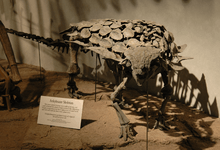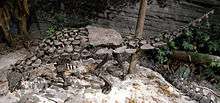Gargoyleosaurus
| Gargoyleosaurus parkpinorum Temporal range: Late Jurassic, 154–150 Ma | |
|---|---|
 | |
| Fossil skeleton, Denver Museum of Nature and Science | |
| Scientific classification | |
| Kingdom: | Animalia |
| Phylum: | Chordata |
| Class: | Reptilia |
| Clade: | Dinosauria |
| Order: | †Ornithischia |
| Family: | †Nodosauridae |
| Subfamily: | †Polacanthinae |
| Genus: | †Gargoyleosaurus Carpenter et al. 1998 |
| Species: | †G. parkpinorum |
| Binomial name | |
| Gargoyleosaurus parkpinorum Carpenter et al. 1998 | |
Gargoyleosaurus (meaning "gargoyle lizard") is one of the earliest ankylosaurs known from reasonably complete fossil remains. Its skull measures 29 centimetres (11 in) in length, and its total body length is an estimated 3 to 4 metres (9.8 to 13.1 ft). It may have weighed as much as 1 tonne (2,200 lb). The holotype was discovered at the Bone Cabin Quarry West locality, in Albany County, Wyoming in exposures of the Upper Jurassic (Kimmeridgian to Tithonian stages) Morrison Formation.[1]
The type species, G. parkpinorum (originally G. parkpini) was described by Ken Carpenter et al. in 1998. A mounted skeletal reconstruction of Gargoyleosaurus parkpinorum can be seen at the Denver Museum of Nature and Science. Gargoyleosaurus was present in stratigraphic zone 2 of the Morrison Formation.[2]
Holotype

The holotype specimen of Gargoyleosaurus parkpinorum was collected by Western Paleontology Labs in 1996 and is currently held in the collections of the Denver Museum of Nature and Science, Denver, Colorado. Besides the holotype, two other partial skeletons are known (although not yet described). The holotype consists of most of the skull and a partial postcranial skeleton. The specimen was originally described as Gargoyleosaurus parkpini by Carpenter, Miles and Cloward in 1998, then renamed G. parkpinorum by Carpenter et al. in 2001, in accordance with ICZN art. 31.1.2A.
Classification
Much of the skull and skeleton has been recovered, and the taxon displays cranial sculpturing, including pronounced deltoid quadratojugal and squamosal bosses. The taxon is further characterized by a narrow rostrum (in dorsal view), the presence of seven conical teeth in each premaxilla, an incomplete osseous nasal septum, a linerarly arranged nasal cavity, the absence of an osseus secondary palate, and, as regards osteoderms, two sets of co-ossified cervical plates and a number of elongate conical spines.[1]
Vickaryous et al. (2004) place Gargoyleosaurus parkpinorum within the Family Ankylosauridae of the Ankylosauria and are in agreement with most previous phylogenetic hypotheses, which place the genus as the sister group to all other ankylosaurids (i.e., members of the Ankylosauridae). These studies however, only utilized the skull, whereas many of the distinctive features of the family Polacanthidae are in the postcranial skeleton.
See also
References
- Carpenter, K., Miles, C. and Cloward, K. (1998). "Skull of a Jurassic ankylosaur (Dinosauria)." Nature 393: 782-783.
- Carpenter, K. (ed.) The Armored Dinosaurs. pp. 454–483. Indiana University Press, Bloomington.
- Vickaryous, Maryanska, and Weishampel (2004). "Ankylosauria". in The Dinosauria (2nd edition), Weishampel, D. B., Dodson, P., and Osmólska, H., editors. University of California Press.
- Killbourne, B. and Carpenter, K. (2005). "Redescription of Gargoyleosaurus parkpinorum, a polacanthid ankylosaur from the Upper Jurassic of Albany County, Wyoming". Neues Jahrbuch für Geologie und Paläontologie, 237, 111-160.
- 1 2 Benton, Michael J. (2012). Prehistoric Life. Edinburgh, Scotland: Dorling Kindersley. p. 278. ISBN 978-0-7566-9910-9.
- ↑ Foster, J. (2007). "Appendix." Jurassic West: The Dinosaurs of the Morrison Formation and Their World. Indiana University Press. pp. 327-329.
External links
- Gargoyleosaurus from the Natural History Museum

